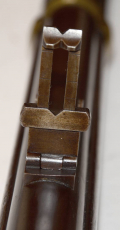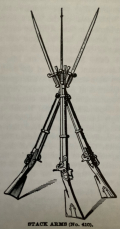site search
online catalog
SCARCE J. HENRY & SON “SABER RIFLE” PENNSYLVANIA MILITIA AND EARLY WAR VOLUNTEERS, ILLUSTRATED IN DRILL MANUALS

$4,500.00
Quantity Available: 1
Item Code: 1193-24
Shipping: Determined by Method & Location of buyer
To Order:
Call 717-334-0347,
Fax 717-334-5016, or E-mail
These scarce, attractive and rather unique looking .58 caliber rifles made by J. Henry & Son have 35-inch octagon-to-round browned barrels, long-range rear sights and brass mounts encompassing the buttplates, barrel bands, stock tips, triggerguards (most of which include unique, recurved bows,) teardrop washers for the lock screws, one pointing rearward and the other down, and patchboxes. The rifle features a stud for a saber bayonet on the right side of the muzzle, hence the company’s designation as their “Saber Rifle,” as distinct from their “Minie Rifle,” very similar, but set up for a socket bayonet. Elements of the rifle show how intertwined the Pennsylvania arms business could be. The barrel bands are like those used by Krider and the triggerguard like that on Justice arms, a common source perhaps being Bernard Lehman of Philadelphia. The patchbox also shows up on both Justice and Krider arms, all likely coming from “scrap patch boxes” sold by Sharps when they went to iron mounts.
Moller gives total production for the Saber Rifle as 952, but this seems to be recorded sales, rather than production (or perhaps even all sales.) Nevertheless, production was limited and likely close to that number. The company’s Minie Rifle was designed by mid-June 1861 and produced (or sold) in July and August, with a total of 245. The company then seems to have turned their attention to the Saber Rifle from September 1861 to March 1862, after which the main buyer, P.S. Justice backed out of the market, at least publicly, imported military arms filled the gap until U.S. production caught up, and the company’s production of military arms shifted composite cadet muskets assembled largely from obsolete, surplus and salvaged parts.
This one rates near Fine for condition, with better than 80 percent original barrel brown, showing just some freckling and salt-and-pepper pitting to the top flat of the octagonal breech and bolster, but leaving the J. HENRY / & SON barrel stamping on the left flat unaffected and sharp. The 35-inch barrel is full length, shifts from octagonal to round, still has its long-range Enfield-style tangent-leaf rear sight in place, complete, and with good color. The metal is smooth from the breech forward and the barrel retains its front sight and stud for a saber bayonet on the right muzzle. The correct ramrod with short, flared tip is in place, as are the narrow, convex brass barrel bands, and the sling swivels. The lock plate is smooth metal and crisply stamped “J. HENRY / & SON” vertically to rear of the hammer, showing mainly gray and thin brown, but with some mottling and thin blue around some of the screws from case hardening. The hammer has good color. Many of the screws show blue. The brass has a pleasing, medium, aged patina. The wood to metal fit is tight. The wood has a warm brown color. The edges of the forestock and ramrod channel are very good, as are those of the lock apron and counterpane. The forestock has just a small check on the lower right, forward of the sight, and the counterpane has a few shallow scratches and small dings. The butt shows a narrow chip on either side of the breechplug tang. (One lock screw slot shows turning.) The patchbox and buttplate have a tight fit, though with a short, narrow splinter missing on the upper left at the shoulder of the buttplate tang. The patchbox and buttplate screws show some pleasing blue. The butt shows some light dings and pressure dents, mostly on the belly, likely from being upright in a gun rack. The action is a little “mushy,” but the bore is clean and the rifling very good, just a little dusty. A few variations are noted even in the very limited production run of these arms: factory records list some with “square” trigger guards and others, “round,” perhaps indicating the common recurved form. At least one is known with an 1858-pattern rear sight, likely a sample sent out on speculation. Some, but not all, have numbers stamped near the bayonet stud at the muzzle, likely mating numbers for saber bayonets. We see no numbers on this one.
The Henry family had been in the gunmaking and gunsmithing business since the 1750s, producing military, fur trade, government Indian treaty guns, commercial and sporting weapons, both complete weapons and parts for other makers. One of their largest outlets in the 1850s for sporting guns was the Philadelphia firm of Justice and Steinmetz. Justice may have spurred their renewed entry into military arms in 1861 with a request for carbine barrels, and he became the major buyer for their Minie Rifle, purchasing 245 in July and August 1861, with a mere 40 others known to have gone to a Bethlehem, PA, militia company. He was also the major purchaser of their Saber Rifle, buying 876 through March 1862, with the company sending out just 6 others as samples to potential buyers, and selling 70 at a discount rate to another Pennsylvania militia company, possibly the “Allentown and Catausauqua Rifles,” which has come down in some sources as the “Catasanga Home Guard.” (Catasauqua is a borough of Allentown, just six miles from Bethelehem- location of the other miltia company, and “home guard” was likely just company shorthand for “militia” rather a title.) All of Justice’s purchases seems to have gone to fulfilling his U.S. government contracts for arms destined for early-war Pennsylvania troops. Moller posits that all of Justice’s purchases were marked with his name, creating the possibility that as few as 76 Saber Rifles (6 samples and the 70 purchased by the militia company) were marked with the Henry company name like this one. On the other hand, we see no mating number for a bayonet on the muzzle of this one, and both the sample and the militia Saber Rifles went out with bayonets, while only about half of those going to Justice had bayonets with them.
This rifle combines eye appeal, condition and history. We even show an illustration from Wilson’s 1862 Infantry Tactics clearly showing these rifles stacked (clearly showing the saber bayonets, triggerguards and patchboxes though credited by Edwards as Justice arms.) This would make a nice addition to a collection of Henry-family made arms, which would be extensive, Pennsylvania made weapons, or military rifles made early in the Civil War, when a happy combination of patriotism and potential profit drew a number of manufacturers and businessmen into (or back into) the military arms business. [sr] [ph:L]
DISCLAIMER: All firearms are sold as collector's items only - we do not accept responsibility as to the shooting safety or reliability of any antique firearm. All firearms are described as accurately as possible, given the restraints of a catalog listing length. We want satisfied customers & often "under" describe the weapons. Any city or state regulations regarding owning antique firearms are the responsibility of the purchaser. All firearms are "mechanically perfect" unless noted, but again, are NOT warranted as safe to fire.
~~~~~~~~~~~~~~~~~~~~~~~~~~~~~~~~~~~
THIS ITEM, AS WITH ALL OTHER ITEMS AVAILABLE ON OUR WEB SITE,
MAY BE PURCHASED THROUGH OUR LAYAWAY PROGRAM.
CLICK HERE FOR OUR POLICIES AND TERMS.
THANK YOU!
Inquire About SCARCE J. HENRY & SON “SABER RIFLE” PENNSYLVANIA MILITIA AND EARLY WAR VOLUNTEERS, ILLUSTRATED IN DRILL MANUALS
For inquiries, please email us at [email protected]
Most Popular
Historical Firearms Stolen From The National Civil War Museum In Harrisburg, Pa »
Theft From Gravesite Of Gen. John Reynolds »
Cavalry Carbine Sling Swivel »
Fine Condition Brass Infantry Bugle Insignia »
featured item
US PATTERN 1858 SMOOTHSIDE CANTEEN IDENTIFIED TO 13TH PENNSYLVANIA VOLUNTEERS
The body of this canteen is covered in a very nice conditioned sky-blue cloth and is strongly stenciled on one side with “13” over “PV” done in white paint. The cover is solid with no signs of moth damage or seam separations. The edges of the… (490-4680). Learn More »




















